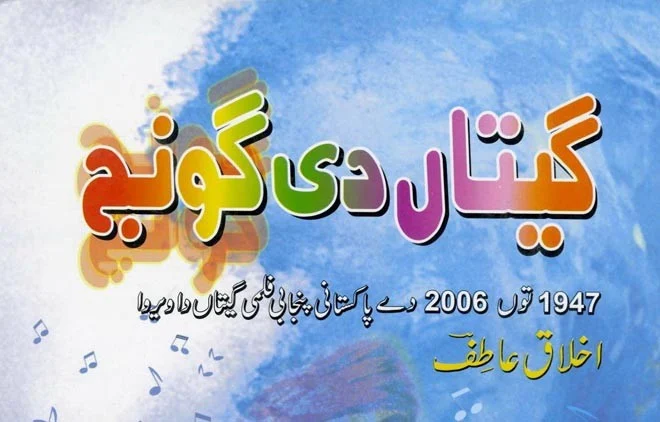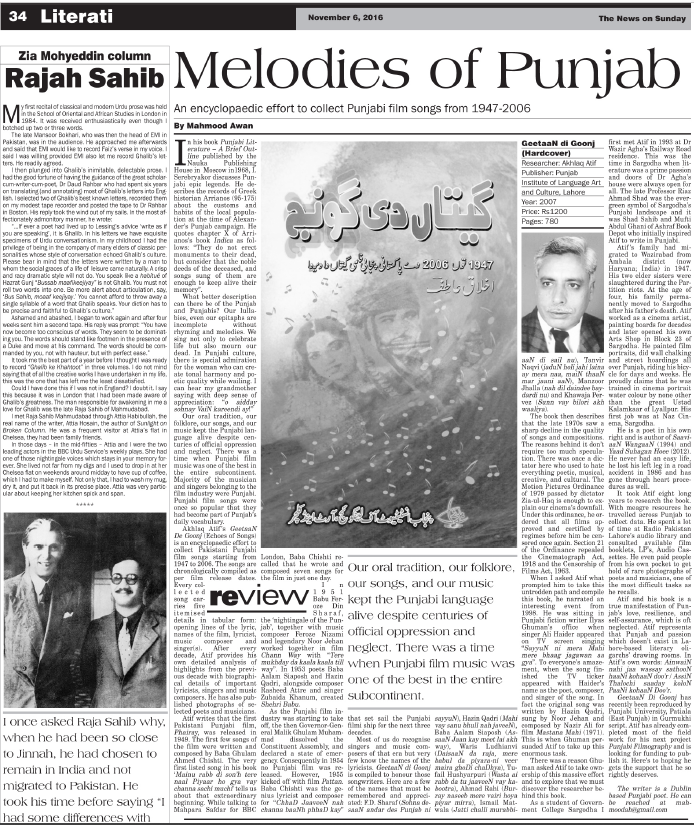Mahmood Awan (The News on Sunday, 6th November 2016)
In his book Punjabi Literature – A Brief Outline published by the Nauka Publishing House in Moscow in1968, I. Serebryakor discusses Punjabi epic legends. He describes the records of Greek historian Arrianos (95-175) about the customs and habits of the local population at the time of Alexander’s Punjab campaign. He quotes chapter X of Arrianos’s book Indica as follows: “They do not erect monuments to their dead, but consider that the noble deeds of the deceased, and songs sung of them are enough to keep alive their memory”.
What better description can there be of the Punjab and Punjabis? Our lullabies, even our epitaphs are incomplete without rhyming and melodies. We sing not only to celebrate life but also mourn our dead. In Punjabi culture, there is special admiration for the woman who can create tonal harmony and poetic quality while wailing. I can hear my grandmother saying with deep sense of appreciation: “o aidday sohnay VaiN kareendi ay!”
Our oral tradition, our folklore, our songs, and our music kept the Punjabi language alive despite centuries of official oppression and neglect. There was a time when Punjabi film music was one of the best in the entire subcontinent. Majority of the musician and singers belonging to the film industry were Punjabi. Punjabi film songs were once so popular that they had become part of Punjab’s daily vocabulary.
Akhlaq Atif’s GeetaaN De Goonj (Echoes of Songs) is an encyclopaedic effort to collect Pakistani Punjabi film songs starting from 1947 to 2006. The songs are chronologically compiled as per film release dates. Every collected song carries five itemised details in tabular form: opening lines of the lyric, names of the film, lyricist, music composer and singer(s). After every decade, Atif provides his own detailed analysis of highlights from the previous decade with biographical details of important lyricists, singers and music composers. He has also published photographs of selected poets and musicians.
Atif writes that the first Pakistani Punjabi film, Phairay, was released in 1949. The first few songs of the film were written and composed by Baba Ghulam Ahmed Chishti. The very first listed song in his book ‘Mainu rabb di son’h tere naal Piyaar ho gya vay channa sachi muchi’ tells us about that extraordinary beginning. While talking to Mahpara Safdar for BBC London, Baba Chishti recalled that he wrote and composed seven songs for the film in just one day.
In 1951 Babu Feroze Din Sharaf, the ‘nightingale of the Punjab’, together with music composer Feroze Nizami and legendary Noor Jehan worked together in film Chann Way with “Tere mukhday da kaala kaala till way“. In 1953 poets Baba Aalam Siaposh and Hazin Qadri, alongside composer Rasheed Attre and singer Zubaida Khanum, created Shehri Babu.
As the Punjabi film industry was starting to take off, the then Governor-General Malik Ghulam Muhammad dissolved the Constituent Assembly, and declared a state of emergency. Consequently in 1954 no Punjabi film was released. However, 1955 kicked off with film Pattan. Baba Chishti was the genius lyricist and composer for “ChhaD JaaveeN nah channa baaNh phhaD kay” that set sail the Punjabi filmi ship for the next three decades.
Most of us do recognise singers and music composers of that era but very few know the names of the lyricists. GeetaaN di Goonj is compiled to honour those songwriters. Here are a few of the names that must be remembered and appreciated: F.D. Sharaf (Sohna desaaN andar des Punjab ni sayyuN), Hazin Qadri (Mahi vay sanu bhull nah javeeN), Baba Aalam Siaposh (AssaaN Jaan kay meet lai akh way), Waris Ludhianvi (DaisaaN da raja, mere babul da piyara-ni veer maira ghoDi chaDhya), Tufail Hushyarpuri (Wasta ai rabb da tu jaaveeN vay kabootra), Ahmad Rahi (Burray naseeb mere vairi hoya piyar mirra), Ismail Matwala (Jatti challi murabbiaaN di sail nu), Tanvir Naqvi (jaduN holi jahi laina ay mera naa, maiN thaaN mar jaani aaN), Manzoor Jhalla (nah dil daindee baydardi nu) and Khawaja Pervez (Sunn vay bilori akh waaliya).
The book then describes that the late 1970s saw a sharp decline in the quality of songs and compositions. The reasons behind it don’t require too much speculation. There was once a dictator here who used to hate everything poetic, musical, creative, and cultural. The Motion Pictures Ordinance of 1979 passed by dictator Zia-ul-Haq is enough to explain our cinema’s downfall. Under this ordinance, he ordered that all films approved and certified by regimes before him be censored once again. Section 21 of the Ordinance repealed the Cinematograph Act, 1918 and the Censorship of Films Act, 1963.
When I asked Atif what prompted him to take this untrodden path and compile this book, he narrated an interesting event from 1998. He was sitting in Punjabi fiction writer Ilyas Ghuman’s office when singer Ali Haider appeared on TV screen singing “SayyuN ni mera Mahi mere bhaag jagawan aa gya“. To everyone’s amazement, when the song finished the TV ticker appeared with Haider’s name as the poet, composer, and singer of the song. In fact the original song was written by Hazin Qadri, sung by Noor Jehan and composed by Nazir Ali for film Mastana Mahi (1971). This is when Ghuman persuaded Atif to take up this enormous task.
There was a reason Ghuman asked Atif to take ownership of this massive effort and to explore that we must discover the researcher behind this book.
As a student of Government College Sargodha I first met Atif in 1993 at Dr Wazir Agha’s Railway Road residence. This was the time in Sargodha when literature was a prime passion and doors of Dr Agha’s house were always open for all. The late Professor Riaz Ahmad Shad was the evergreen symbol of Sargodha’s Punjabi landscape and it was Shad Sahib and Mufti Abdul Ghani of Ashraf Book Depot who initially inspired Atif to write in Punjabi.
Atif’s family had migrated to Wazirabad from Ambala district (now Haryana; India) in 1947. His two elder sisters were slaughtered during the Partition riots. At the age of four, his family permanently moved to Sargodha after his father’s death. Atif worked as a cinema artist, painting boards for decades and later opened his own Arts Shop in Block 23 of Sargodha. He painted film portraits, did wall chalking and street hoardings all over Punjab, riding his bicycle for days and weeks. He proudly claims that he was trained in cinema portrait water colour by none other than the great Ustad Kalamkaar of Lyallpur. His first job was at Naz Cinema, Sargodha.
He is a poet in his own right and is author of SaaviaaN WangaaN (1994) and Yaad Suhagan Hoee (2012). He never had an easy life, he lost his left leg in a road accident in 1986 and has gone through heart procedures as well.
It took Atif eight long years to research the book. With meagre resources he travelled across Punjab to collect data. He spent a lot of time at Radio Pakistan Lahore’s audio library and consulted available film booklets, LP’s, Audio Cassettes. He even paid people from his own pocket to get hold of rare photographs of poets and musicians, one of the most difficult tasks as he recalls.
Atif and his book is a true manifestation of Punjab’s love, resilience, and self-assurance, which is oft neglected. Atif represents that Punjab and passion which doesn’t exist in Lahore-based literary oligarchs’ drawing rooms. In Atif’s own words: AinwaiN nahi jaa wassay sathooN haaNi kohaaN doo’r / AssiN Thalochi saaday koloN PaaNi kohaaN Doo’r.
GeetaaN Di Goonj has recently been reproduced by Punjabi University, Patiala (East Punjab) in Gurmukhi script. Atif has already completed most of the fieldwork for his next project Punjabi Filmography and is looking for funding to publish it. Here’s to hoping he gets the support that he so rightly deserves.
GeetaaN di Goonj (Hardcover)
Researcher: Akhlaq Atif
Publisher: Punjab Institute of Language Art and Culture, Lahore
Year: 2007
Price: Rs1200
Pages: 780
Published on 6th November 2016 in The News on Sunday.
https://www.thenews.com.pk/tns/detail/562058-melodies-punjab


